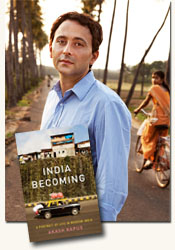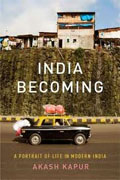author interview
book reviews:
· general fiction
· chick lit/romance
· sci-fi/fantasy
· graphic novels
· nonfiction
· audio books
· author interviews
· children's books @
curledupkids.com
· DVD reviews @
curledupdvd.com
newsletter
win books
buy online
links
home
for authors
& publishiss
for reviewers

|
|||||
 book is about the impact of seismic economic and social changes on the people of India. Using extended vignettes featuring an interesting cast of characters, Kapur looks at how people and their lives are altered when a nation undergoes changes that are a clear break from its past. Akash Kapur talked to CurledUp.com contributor Ram Subramanian on the telephone about India and how Western audiences have approached his book. Interviewer Ram Subramanian: The title of your book comes from an Albert Einstein quote with reference to the United States. In the Indian context, could it be that India is “becoming, and never being” because it doesn’t know what it wants to be? In the lives of the young people featured in the book , did you sense a strong element of confusion? Do you think this confusion is unique to India because of the speed and extent of change or is it universal? Akash Kapur: I think confusion might be a bit of a harsh word here. There is an element of uncertainty and ambivalence in India today. The “becoming” part in the title refers to the process of reinvention that Einstein alluded to and also portrays India as being in a state of transition and becoming something else, something that the individual characters in the book are not sure of. The young in India today seem to have the zeal of a convert in completely embracing the change and disowning the past. For example, Hari as an employee is not quite the typical Indian employee of the past (in his lack of loyalty to his employer, for instance) and Veena is not quite the typical young Indian woman of yesterday. Are the Haris and the Veenas hurtling toward the present without any anchor or safety net? The processing of embracing change is very much tentative and ambivalent. Everybody in India is torn between two worlds and is figuring out how to integrate both the old and the new. So I think you have an aspect of society where there is a headlong jump into materialism, but there is also a part of society that is very much self-aware and is thinking through about what is happening in India today and struggling to make sense of it. Is there a danger in rushing to embrace change without a safety net? Yes, there is. When a country changes or a person changes, there is often not much scope for going back to where you once where. Can India go back to what it was twenty years ago? Yes, I can see that happening. But I don’t think the current change in India is complete and that people have reached an end stage. The change is still ongoing and people are still trying to figure out what they are “becoming.” Two of the people featured in the book–Hari and Veena–appear to revert to tradition at the end after attempting to challenge it. Hari is quite willing to switch jobs to further his career, but reverts to tradition when faced with financial problems. Veena is the independent career woman who, in the end, comes to realize that perhaps motherhood is not a bad option. Did you sense the siren song of tradition still holding Indians to their past at least in certain areas? I believe the two of them are very striking examples of modernization and are not necessarily indicative of everybody in India. Yes, Hari and Veena try to break away from tradition, but having said that, I believe they are still tightly held by their family and have a very strong connection to their family members. When Hari took me to visit his town, I could see that he had a strong sense of attachment. While in India, Hari kept telling me about how eager he was to go to London for his job. When I met him in London, he kept talking about how he was going to go back to his hometown and set up something for himself there. Even when Hari and Veena, for example, talk about leaving things behind, I don’t think they cut the bar completely. Selvi, the young woman working in a call center, is the daring village girl who wants to be independent and yet seems quite willing, in the end, to accept her parents’ plans for her. Veena is the independent career woman who flouts convention, first by divorcing her husband, and then by living with her boyfriend, only to “succumb” to marriage and possible motherhood at the end. How strong is the pull of tradition for Indian women? I think the pull of tradition is very strong for women in India. Modernization and globalization have not wiped this slate clean. Selvi is a very good example of this. She thinks she is going to break away and she ends up not breaking away. In her case, I think it’s both a good and a bad thing. Denying her freedom and individual liberty was sad from my perspective, but in the end, it was nice to know that she was strongly connected to her family and it was one place that she could always go back to, particularly in difficult times. What I wanted to show in the book was how complicated these things are and how contradictory things (liberty and the bonds of tradition) are going on at the same time. While these may not make great sound bites, I think that’s how reality is and I wanted to portray it honestly. Reality is always multilayered, not clean, isn’t it? Yes, absolutely. While I think that’s true anywhere in the world, it is particularly true in India at the moment where there is so much going on and so many different influences playing out. Veena’s headlong pursuit of a career and then an about-turn to motherhood may not be culture-specific and may be more universal. In Veena’s case, a life-threatening illness forces her to confront her future. Her life doesn’t go exactly as she planned it, or as I quote Anton Chekhov in the book, “Life does not agree with philosophy.” That’s what I found when I followed these characters for five years. Leaving aside national cultures, I found out just how complicated human life is. The book has an upbeat tone, for the most part, till the time you learn about Sudha (Selvi’s roommate) and her tragedy. From then on your tone takes a new turn as you sense that the disruptive changes in India have tremendous personal consequences for some. You become a less objective interviewer in the second half of the book and more of an interventionist. How and why did this happen? The narrative structure of the book is a journey that parallels my own journey when I moved back to India. I had been away for twelve years and when I returned I was initially drawn by the optimism and the energy that the economic liberalization brought. After I had lived in India for a few years, I realized that things are a lot more complicated and that there are downsides to development and there are costs to prosperity. This was my journey, and I believe this is also the path that India took, because if you read the Indian media today, there is much less cheerleading for change and much more acknowledgement of the complexity of the state that India is in. You become more of an interventionist in the second part of the book. Yes, in particular, in the environmental chapter, when I find my home affected by toxic effluents. The book features stories of people whose experiences are universal. There is Hari wrestling with the dilemma of coming out, there is Veena with her unconventional lifestyle struggling with the sense of her biological clock ticking away. And yet, the Western audience (from your radio interviews and The New Yorker excerpt) seems to be more interested in Sathy, the agriculturalist and Ramadas, the cow broker. Are Western notions of India still rooted in India’s past? While it is true that the West seems to better relate to their image of India of the past, I think things have changed in the last few years. The West’s understanding of India has become more layered and complex as compared to when I first started writing about India thirteen years ago. Then, to sell a story about India, you had to write about certain themes such as poverty and caste. There is interest beyond the stereotype in many publications today.
|
|||||
| fictionnsf/f · comic books · nonfiction · audio newsletter · free book contest · buy books online review index · links · · authors & publishiss reviewerss |
|
| site by ELBO Computing Resources, Inc. | |


